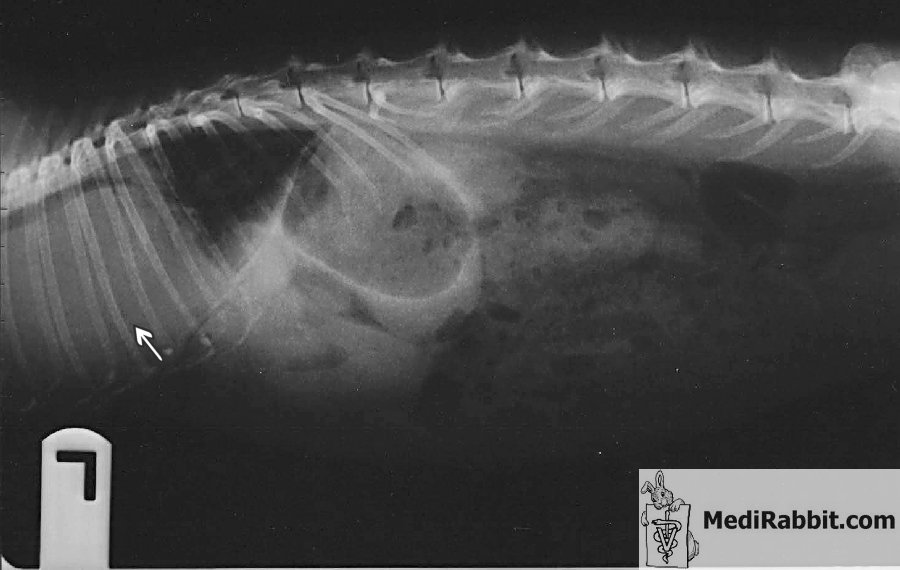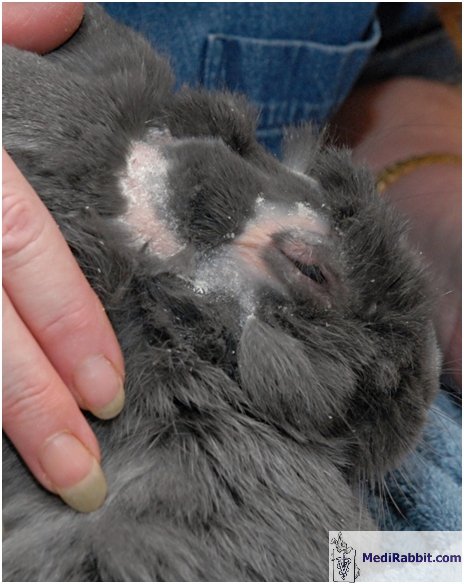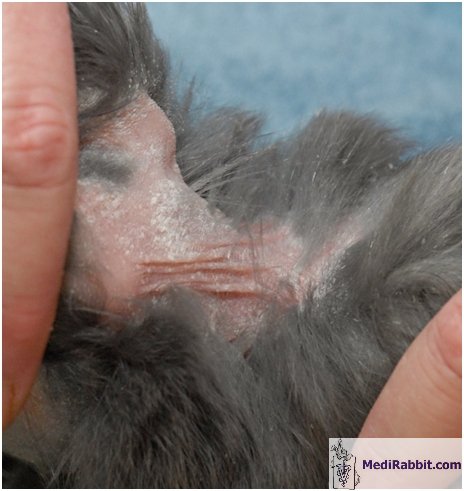Sebaceous
adenitis associated to thymoma in rabbits
Esther van
Praag, Ph.D.
|
MediRabbit.com is
funded solely by the generosity of donors. Every
donation, no matter what the size, is appreciated and will aid in the
continuing research of medical care and health of rabbits. Thank you |
Warning: this file
contains pictures that may be distressing to some persons
|
The etiology of sebaceous adenitis – also called
inflammation of the sebaceous glands - is not well understood; it is
considered idiopathic, inherited or endocrine. In rabbits, the disorder appears
to have an inherited autoimmune origin, accompanied by a defect of the fatty
acids metabolism. An autoimmune origin also established in dogs, after immunohistological analysis of skin samples, but also
from the successful treatment with cyclosporine, an immunosuppressant drug. Different types of thymoma
have been observed in rabbits: ·
Thymoma, with neoplastic development of the gland; ·
Lymphocytic thymoma, with
increased presence of lymphocytes; ·
Cystic thymoma, with
accumulation of fluid in the gland. Clinical characteristics The
first clinical manifestations of sebaceous adenitis resemble those of skin
allergy: inflamed sebaceous gland with progressive destruction of the glands
and the adjacent hair follicles, accompanied by inflammation of the hair follicles
(mural lymphocytic folliculitis). The condition worsens over time. Hair
growth stops, the fur is thinning, and alopecic patches appear. The skin
becomes erythematous, with abnormal thickening (hyperkeratosis). Scales
adhere tightly to the skin. Infiltration of lymphocytes into the basal layer
of the epidermis (interface dermatitis) is furthermore observed in rabbits.
This causes changes in the basal cells of that layer, necrosis of
keratinocytes and occasionally inflammation of the follicular-dermal
interface (interface folliculitis). Sebaceous
adenitis in rabbits can occur in patches or be progressive, with non-pruritic
scaling on the head. It later spreads to the neck, the pelvic region, and the
rest of the body. Lesions are often symmetrical over the head and abdomen. Diagnosis Radiography of the chest helps rule out thymoma. Inflammation
of the sebaceous glands is often mistakenly diagnosed as skin allergy. As a
result, it is treated inappropriately. Skin problems such as fungal
dermatitis, parasitic infestation or defluxion will often be considered, when
the proposed skin allergy treatment fails to bring an improvement. This skin
condition should furthermore be differentiated from thymoma-associated
exfoliative dermatitis, cutaneous lymphoma, or dermatitis caused by
autoimmune hepatitis. Treatment Depending
on the health condition of the rabbit, the type of thymoma,
and prognosis, different treatment options are available. ·
Radiation therapy has brought remission and decrease of the size of
the tumor in rabbits suffering from thymoma, with
neoplastic development of the gland; ·
Corticosteroids, e.g., prednisolone, can bring relief in case of
lymphocytic thymoma; ·
Drainage of fluids has successfully brought relief in case
of cystic thymoma, with accumulation of fluid in
the gland. Since
growth of thymoma is slow, it is sometimes chosen
not to treat. The tumor will increase in time and compress heart and lungs,
leading to compression of the heart and increase respiratory distress. If thymoma is accompanied by sebaceous adenitis, a regular
brushing also helps to remove the dandruff, which is a source of secondary
bacterial infection. Treatments with an antifungal,
corticosteroid or an immunosuppressant drug did not bring improvement. The
administration of fatty acids, vitamin A or retinoids
(e.g. isotretinoin, etretinate) can be attempted,
but the toxicity of these compounds must be taken into account. The combined administration of cyclosporine
(5 mg/kg, PO, sid), medium chain triglycerides
and essential fatty acids, accompanied by topical application of propylene
glycol sprays was successful in the treatment of sebaceous
adenitis in a rabbit. Two months later, remission was observed, with new
hair growth. Since this treatment
is costly, euthanasia should be considered as a humane alternative,
so as not to unnecessarily prolong the rabbit's pain
and suffering.
References Florizoone K. Thymoma-associated exfoliative dermatitis in a rabbit. Vet Dermatol 2005;16:281-284. Jassies - Van der Lee A, van Zeeland
Y, Kik M, Schoemaker N. Successful treatment of
sebaceous adenitis in a rabbit with ciclosporin and
triglycerides. Vet Dermatol 2009;20:67-71. Quesenberry KE,
Carpenter JW. Ferrets, rabbits and rodents. Clinical Medicine and Surgery. St
Louis, USA: Saunders; 2004. White SD, Linder KE, Schultheiss P,
Scott KV, Page G, Taylor M, Best SJ, Walder EJ, Rosenkrantz W, Yager JA. Sebaceous
adenitis in four domestic rabbits (Oryctalagus
cuniculus). Vet Dermatol 2000;11:53-60. |
|||||||||||
A special thanks to
Angie Lai (Singapore), to Nancy Martin (USA) for sharing radiographs and
pictures of the rabbit Bella, respectively, and to Debbie Hanson (USA) for making
the video.
e-mail: info@medirabbit.com







